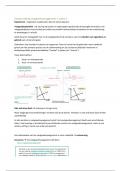Other
Unit 6 Assignment A (Distinction)
- Institution
- PEARSON (PEARSON)
This is an in depth assignment on Unit 6A. It discuses the criminal court system, legal framework, and criminal law that criminal investigators must adhere to, examples of crime in terms of Mens Rea and Actus reus, the legal framework and criminal law the criminal investigator must adhere to and th...
[Show more]












